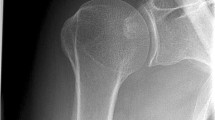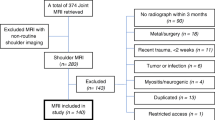Abstract
The relative prevalence of various acromial shapes, appearance of the coracoacromial ligament and enthesophytes along the inferior aspect of the acromioclavicular joint in patients with and without rotator cuff tears were evaluated. Of 76 patients with clinical instability and impingement, 31 had a normal rotator cuff and 45 demonstrated a partial or full tear of the supraspinatus tendon at surgery. Results were compared with those from magnetic resonance (MR) scans of 57 asymptomatic volunteers. Of the 45 patients with a supraspinatus tear, 38% (17) had a flat acromial undersurface (type I), 40% (18) had a concave acromial undersurface (type II), 18% (8) had an anteriorly hooked acromion (type III), and 4% (2) had an inferiorly convex acromion (type IV). Among the 31 patients with a normal rotator cuff at surgery and the 57 asymptomatic volunteers, the respective prevalences of the type I acromion were 39% (12) and 44% (25), of type II 48% (15) and 35% (20), type III 3% (1) and 12% (7), and type IV 10% (3) and 9% (5). Shoulders with surgically proven rotator cuff tears showed a tendential association with a type III acromion (8/45) and statistically significant associations with a thickened coracoacromial ligament (17/45) and acromioclavicular enthesophytes (18/45). For the association between inferiorly directed acromioclavicular joint enthesophytes and rotator cuff tears, age appears to be a confounding factor. The type IV acromion, newly classified by this study, does not have a recognizable association with rotator cuff tears. Assessment of the osseous-ligamentous coracoacromial outlet by may prove helpful to the orthopedic surgeon in patients for whom surgical decompression is contemplated.
Similar content being viewed by others
References
Neer CS. Anterior acromioplasty for the chronic impingement syndrome in the shoulder. A preliminary report. J Bone Joint Surg [Am] 1972; 54:41–50.
Neer CS. Impingement lesions. Clin Orthop 1983; 173: 70–77.
Ozaki J, Fujimoto S, Nakagawa Y, Masuhara K, Tamai S. Tears of the rotator cuff of the shoulder associated with pathological changes in the acromion. A study in cadavers. J Bone Joint Surg [Am] 1988; 70: 1224–1230.
DePalma AF, Disorders associated with biologic aging of the shoulder. In: Surgery of the shoulder, 3rd edn Philadelphia: Lippincott, 1983: 242–298.
Cone RO, Resnik D, Danzig L. Soulder impingement syndrome: radiographic evaluation. Radiology 1984; 150: 29–33.
Hardy DC, Vogler JB, White RH. The shoulder impingement syndrome: prevalence of radiographic findings and correlation with response to therapy. AJR 1986; 147: 557–561.
Neumann CH, Petersen SA, Jahnke AH. MR imaging of the labral-capsular complex: normal variations. AJR 1991; 157: 1015–1021.
Bigliani LU, Morrison DS, April EW. The morphology of the acromion and its relationship to rotator cuff tears. Orthop Trans 1986; 10: 216.
Codman EA. Ruptures of the supraspinatus tendon 1834 to 1934. J Bone Joint Surg [Am] 1937; 19: 643–653.
Zuckerman EA, Kummer FJ, Cuomo F, Simon J, Rosenblum S, Kotz N. The influence of coracoacromial arch anatomy on rotator cuff tears. J Shoulder Elbow Surg 1992; 1:4–12.
Epstein RE, Schweitzer ME, Frieman BG, Fenlin JM, Mitchell DG. Hooked acromion: prevalence on MR images of painful shoulders. Radiology 1993; 187: 479–481.
Author information
Authors and Affiliations
Rights and permissions
About this article
Cite this article
Farley, T.E., Neumann, C.H., Steinbach, L.S. et al. The coracoacromial arch: MR evaluation and correlation with rotator cuff pathology. Skeletal Radiol. 23, 641–645 (1994). https://doi.org/10.1007/BF02580386
Published:
Issue Date:
DOI: https://doi.org/10.1007/BF02580386




